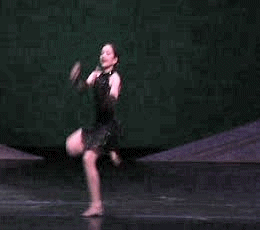
Split leap
Encyclopedia

Split (gymnastics)
A split is a human body configuration in which the legs are parallel to each other and extended in opposite directions. Splits are performed in various athletic activities, including dance, figure skating, gymnastics, martial arts, contortionism, synchronized swimming, cheerleading and yoga...
position after leaping or jumping
Jumping
Jumping or leaping is a form of locomotion or movement in which an organism or non-living mechanical system propels itself through the air along a ballistic trajectory...
from the floor, respectively, while still in the air. Split leaps and split jumps are both found in various genres of dance
Dance
Dance is an art form that generally refers to movement of the body, usually rhythmic and to music, used as a form of expression, social interaction or presented in a spiritual or performance setting....
including acro dance
Acro dance
Acro dance is a style of dance that combines classical dance technique with precision acrobatic elements. It is defined by its athletic character, its unique choreography, which seamlessly blends dance and acrobatics, and its use of acrobatics in a dance context...
, ballet
Ballet
Ballet is a type of performance dance, that originated in the Italian Renaissance courts of the 15th century, and which was further developed in France and Russia as a concert dance form. The early portions preceded the invention of the proscenium stage and were presented in large chambers with...
and jazz dance
Jazz dance
Jazz dance is a classification shared by a broad range of dance styles. Before the 1950s, jazz dance referred to dance styles that originated from African American vernacular dance. In the 1950s, a new genre of jazz dance—modern jazz dance—emerged, with roots in Caribbean traditional dance...
, and in gymnastics
Gymnastics
Gymnastics is a sport involving performance of exercises requiring physical strength, flexibility, agility, coordination, and balance. Internationally, all of the gymnastic sports are governed by the Fédération Internationale de Gymnastique with each country having its own national governing body...
. Split jumps may also serve as a form of exercise, and the term split jump is also commonly used to describe similar body movements in figure skating
Figure skating
Figure skating is an Olympic sport in which individuals, pairs, or groups perform spins, jumps, footwork and other intricate and challenging moves on ice skates. Figure skaters compete at various levels from beginner up to the Olympic level , and at local, national, and international competitions...
.
Split leaps and split jumps require significant flexibility and strength. Flexibility and strength are both needed to attain a split position without the aid of external leg support. Also, sufficient strength is needed to propel the body into the air with enough kinetic energy
Kinetic energy
The kinetic energy of an object is the energy which it possesses due to its motion.It is defined as the work needed to accelerate a body of a given mass from rest to its stated velocity. Having gained this energy during its acceleration, the body maintains this kinetic energy unless its speed changes...
to compensate for the loss of momentum
Momentum
In classical mechanics, linear momentum or translational momentum is the product of the mass and velocity of an object...
that results from raising the legs into a split position.
Some variations of split leaps and split jumps may be named according to the type of split that is performed, while others may use nomenclature associated with specific dance genres. For example, a straddle (sometimes called side) split leap incorporates a straddle split, with legs extended symmetrically to the sides, whereas a grand jeté, which involves a front split, derives its name from ballet terminology.
The aesthetic quality of a split leap or split jump depends in large part on the application of various dance techniques. In particular, emphasis is often placed on pointing the feet while airborne, especially during the split, so as to extend the leg lines. Also, proper technique typically calls for straight legs and a full split position at the apex
Apex (geometry)
In geometry, an apex is the vertex which is in some sense the highest of the figure to which it belongs.*In an isosceles triangle, the apex is the vertex where the two sides of equal length meet, opposite the unequal third side....
of the leap (or jump). There are, however, variations that run counter to conventional dance technique. For example, the feet may be intentionally oriented at right angles to the legs to produce a notable, unusual aesthetic.

